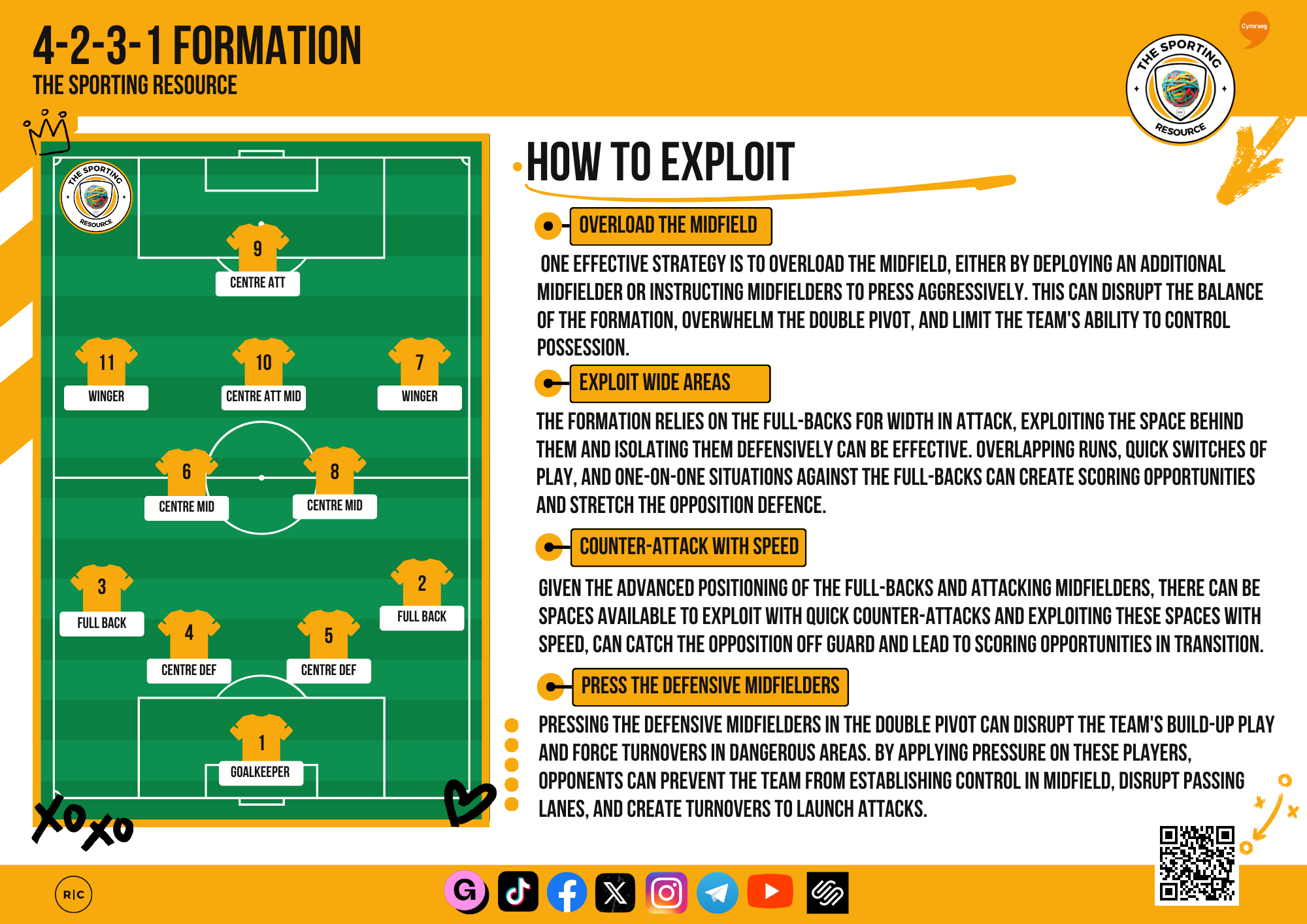Breakdown:
Among the many available formations, the 4-2-3-1 stands as a versatile and effective system, utilised by some of the most successful teams worldwide, but what exactly lies beneath the surface of this popular formation? In this resource, we embark on a comprehensive journey to better understand the 4-2-3-1 formation.
As you delve into the depths of this formation, consider the following questions:
💡Adaption: How can you adapt the 4-2-3-1 formation to suit the strengths and weaknesses of your team?
🤝 Defensive Strategies: What defensive strategies can you employ to maintain compactness and deny space to the opposition?
💡Control Possession: In what ways can you utilise the midfield trio to control possession and dictate the tempo of the game?
🤝 Transitions: What role does transition play in the success of the 4-2-3-1 formation, and how can you optimise your team's transition from defence to attack and vice versa?
Join us on this exploration of the 4-2-3-1 formation, and let's uncover the keys to success together.
We’ll be sharing invaluable insights and strategies to help you break down this tactical setup effectively. Whether you’re coaching at the grassroots level or a professional league, hopefully, these coaching education tips will empower you to outwit your opponents.
Phases
When using the 4-2-3-1 formation, it’s important to think about what each player should do in different parts of the game.
Whether they have the ball or not, or when the game is changing, every player has specific jobs that are crucial for the team to succeed. When we have the ball, players need to work together and make good decisions as they pass and move, whether they’re starting an attack, recycling possession, creating scoring opportunities, or trying to score.
When we don’t have the ball, players must stay close to each other, put pressure on the opponents, and defend well. And when there’s a change in possession, players need to quickly adjust their positions and mindset. By understanding and fulfilling their roles and responsibilities in each phase and transition, our team can play better and be more effective using the 4-2-3-1 formation.
Let’s look at these a little closer:
Roles and Responsibilities
For coaches eager to implement a 4-2-3-1 formation here are some Roles and Responsibilities:
In-Possession
Out-of-Possession
Transitions
These detailed descriptions outline the specific responsibilities of each player in the 4-2-3-1 formation during attacking and defensive transitions. It emphasises the importance of quick decision-making, intelligent positioning, and cohesive teamwork in successfully transitioning between phases of play.
Players must act decisively during attacking transitions to capitalise on opportunities presented by turnovers or quick ball recoveries. Players must exhibit speed, coordination, and awareness, with the goalkeeper initiating quick distribution and outfield players quickly transitioning from defensive to attacking positions. Maintaining proper spacing and timing of runs is vital to exploit gaps in the opposition's defence effectively.
On the other hand, defensive transitions require a rapid shift in mindset from attacking to defensive duties. Players must promptly track back to regain defensive shape, prioritise closing down space, and anticipate opposition movements to thwart potential counter-attacks. Communication, discipline, and collective effort are key factors in successfully nullifying the opposition's attacking threats and regaining control of the game
Strengths and Weaknesses
The 4-2-3-1 formation is widely favoured for its ability to blend defensive stability, midfield control, attacking adaptability, and tactical versatility, making it a popular choice for teams seeking success on the pitch.
Strengths
Weaknesses
Despite its strengths, this formation presents certain vulnerabilities that coaches must address through astute tactical adjustments, strategic player positioning, and heightened awareness during matches. By carefully managing these potential weaknesses, teams can maximise the effectiveness of the 4-2-3-1 formation and enhance their chances of achieving positive results on the field.
How to exploit
Here are four key areas on how to exploit a 4-2-3-1 formation:
It's crucial to consider key strategies for exploiting its vulnerabilities effectively. Overloading the midfield with an extra player or employing aggressive pressing can disrupt the balance of the double pivot and limit the team's ability to control possession. Exploiting the wide areas by isolating the full-backs and utilizing overlapping runs or one-on-one situations can create scoring opportunities and stretch the opposition defence.
Capitalising on transitional moments with quick counter-attacks can exploit spaces left behind the advanced positioning of the full-backs and attacking midfielders. Pressing the defensive midfielders in the double pivot can disrupt the team's build-up play and force turnovers in dangerous areas, preventing them from establishing control in midfield. By focusing on these key considerations, teams can effectively exploit the vulnerabilities of the formation.

Summary
The 4-2-3-1 formation stands out as a versatile tactical approach that encompasses both defensive solidity and attacking fluidity. It provides a robust defensive structure, facilitates midfield control, and encourages dynamic attacking movements. However, coaches must be mindful of potential challenges. These include potential overcrowding in midfield areas, limited width in certain attacking zones, and the need to adequately support the lone striker. Coaches are advised to assess player capabilities, make tactical adjustments, and anticipate opposing strategies to effectively implement the 4-2-3-1 formation. Customisation and fine-tuning of the formation are essential to optimise performance and maximise success on the field, aligning with the team's unique strengths and weaknesses.














